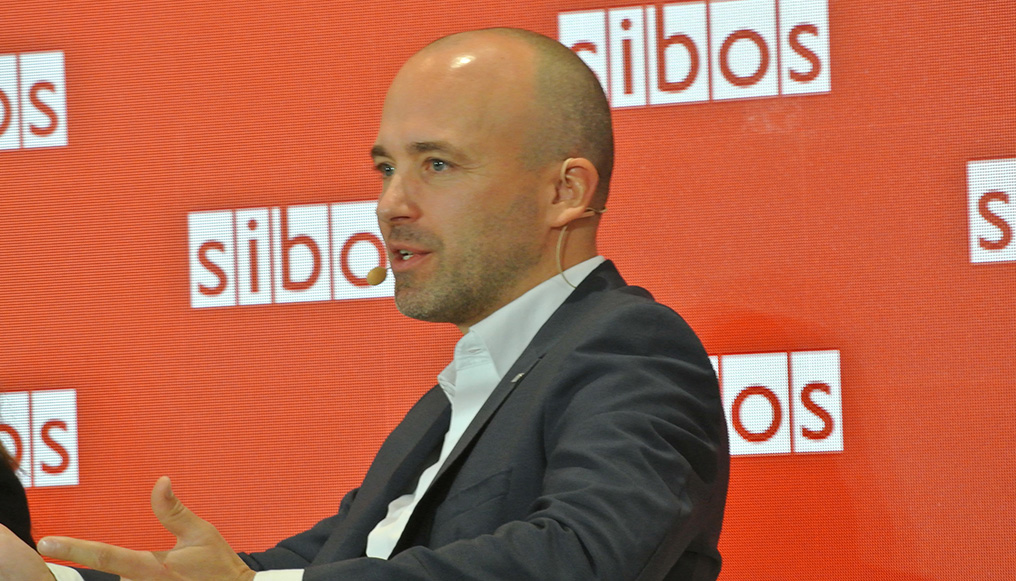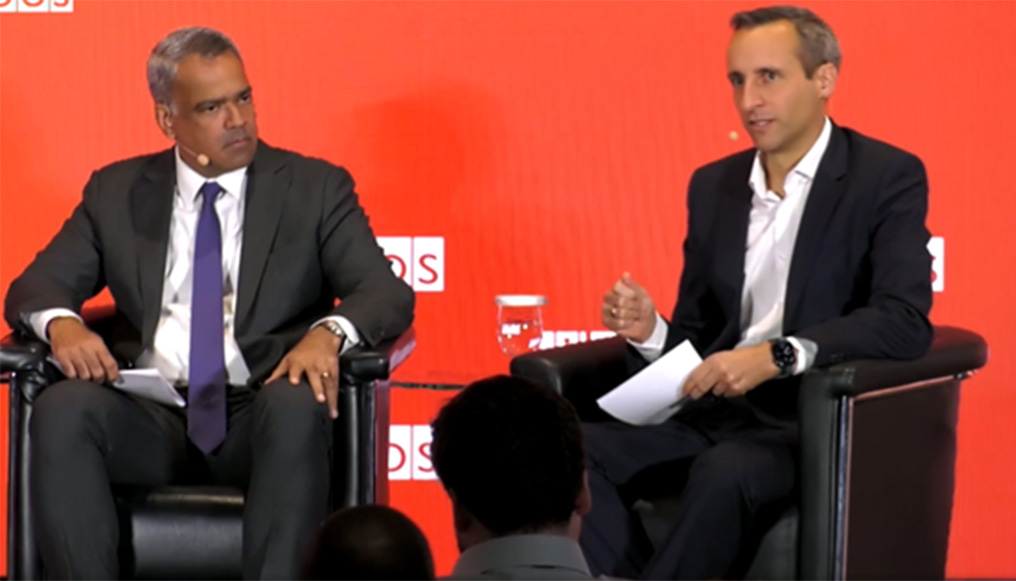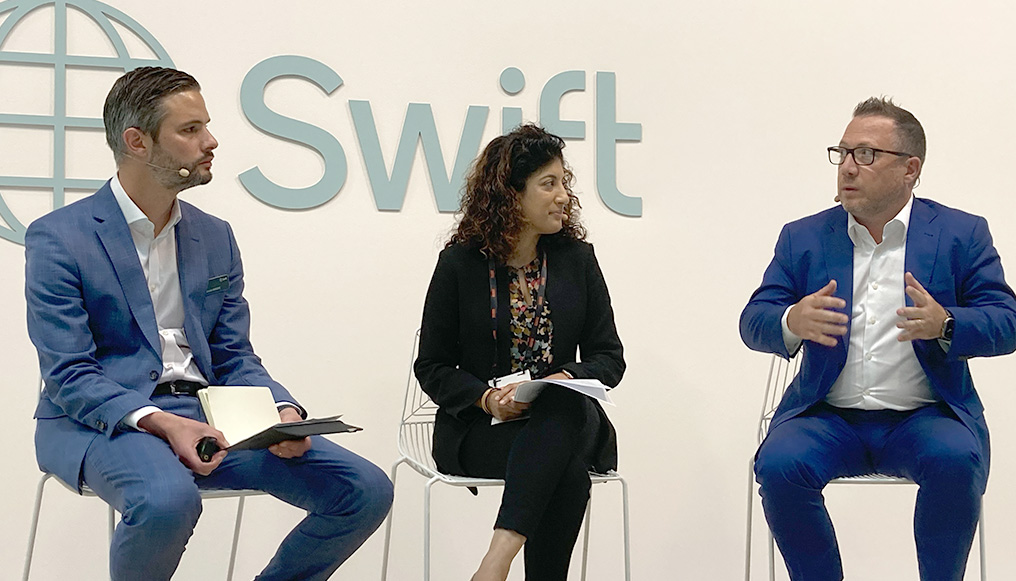06 October 2023
Sibos returned to the Metro Toronto Convention Centre (MTCC) for 2023, with instant treasury, ISO 20022, interoperability and AI high on the agenda. In one of four post-Sibos reports, flow’s Clarissa Dann explores the conference’s key payment themes.
MINUTES min read
The CN tower, the Rogers Centre, and Ripley's Aquarium of Canada provided the backdrop to this year’s Sibos, which returned to Toronto after six years. While the location and architecture remain largely unchanged, Sibos’s agenda has, unsurprisingly, moved on significantly. From striking new technological developments to bold community initiatives that are helping to unlock frictionless and fast payments, the 9,000-strong conference delegation had plenty of talking points.
To kick off this year’s event, performers at the opening plenary danced in unison, as birds flew in formation on the screen behind them. If the symbolism was insufficient, the question posed to the audience during the performance made Sibos’s message clear: “Can we be a force for good and create new opportunities?”. The answer: “We can when we work together”.
The performance mirrored the conference’s theme for 2023 – “collaborative finance in a fragmented world” – which was summed up in the opening address from Swift CEO Javier Pérez-Tasso, “It is more important than ever that we maintain the momentum, and that we, as a community, focus on adopting and using all of these new capabilities and innovations,” he stressed.
But how is collaboration helping to remove fragmentation and shape the future of finance? This article, one of four post-Sibos 2023 reflections, takes a closer look at six key payments takeaways from the conference.

Pictured: Dancers take a bow at Sibos’s Opening Plenary event
1) Instant everything
Instant expectations across multiple sectors are driving fundamental changes to the way corporates, in collaboration with their banking partners, manage their treasury departments – with an ongoing transition from batch and daily processes to more real-time systems underway.
The reasons for embarking on this transition (or not, in some cases) vary from sector to sector: some corporates might want access to information so they can make real-time decisions based on their available liquidity, whiles others might be focused on enabling instant payments to meet changing customer and business demands. Regardless of the motivation, there are, according to Christof Hofmann, Global Head of Corporate Cash Management, Deutsche Bank, three key areas that must first be addressed:
- The corporate component. Corporates should be able to understand and use the relevant technologies, such as APIs; have a centralised and consistent data system; and be able to automate their own workflows to enable straight-through processing.
- The transactional component. Banking providers should ensure that the relevant information is available to treasurers as and when they need it to ensure they can make the right decisions for their business and their customers. This is being seen through the enablement of APIs (this topic is explored in detail in the flow article, APIs and the reality of real time), instant payments and pre-validation tools, among others tools.
- The non-transactional component. While non-transactional areas such as know-your customer (KYC) and compliance checks will never be fully instant, they are a key enabler of instant treasury – and should be part of the treasurer’s broader digital experience.

Pictured: Christof Hofmann (Deutsche Bank) during the conference panel session, Instant treasury: Everything, everywhere, all at once
In achieving these aims there are, inevitably, challenges. Carolina Caballero, Director, Head of AP Payments and Recon, Amazon, for example, outlined the need for shared API standards, such that corporates do not have to develop individual APIs for each integration, as well as a shared infrastructure for the purpose of pre-validation of payments.
For Hofmann, “having these standard discussions earlier in the process could really help to avoid the repetition of efforts that we see within the industry. And to make this work long-term, greater collaboration to drive greater standardisation will be critical”.
2) ISO 20022: what next?
It would not be Sibos without ISO 20022 – and this year was no exception. The past few months have been a significant few months for the new global payment messaging standard, which has now gone live for high-value payment systems in Australia (RITS), Canada (LYNX), Europe (EURO 1 and T2) and New Zealand (ESAS), as well as for cross-border payments globally (this topic is explored in detail in the flow article, Getting ISO 20022 over the line).
“There is a lot of value and use cases to be realised from the ISO 20022 standard”
The benefits, however, have not been immediate. And with only 15% of Swift’s payment volume currently using the ISO 20022 standard, there is still some way to go. In the panel session, Extending ISO 20022 benefits to corporates, Christian Fraedrich, Head of Business Architecture, Deutsche Bank Corporate Bank, it is premature to talk about the materialised benefits for two reasons:
- Adoption. The industry needs to focus on breadth of adoption, meaning the need for everyone to talk the same, common language, as well as the depth of adoption, meaning the entire industry can send and receive ISO 20022 messages natively.
- Data quality. For the full benefits to be realised, the industry needs to ensure that the data being used for ISO 20022 messages is of a high quality.
On these two fronts, getting corporates onboard is a big part of the equation. “From a corporate perspective, there is a lot of value and use cases to be realised from the ISO 20022 standard, including improvements to straight-through processing rates, a reduction in false positives and investigations and the enablement of on-behalf of payments, to name just a few,” said Fraedrich. “But to get to this destination, it has to be a journey together with the banks.”

Pictured: David Rego (Standard Chartered) and Christian Fraedrich (Deutsche Bank)
As part of this work, it will require banks to provide the necessary education and training materials not just to corporates, but to ERP and TMS service providers as well. So while ISO 20022 has “arrived”, there is still plenty of work to be done in ensuring everybody is speaking the right dialect, becoming ISO native and cleaning up the data – both from a bank and corporate perspective. And the sooner the industry is able to do all this, the better.
3) A revolution in payment investigations
Today, the majority of payment exceptions and investigations are handled through free-format MT messages that allow for limited automation, and these are exchanged point-to-point, which necessitates the involvement of every bank in the chain. The inefficiencies introduced by these processes mean that around 5% of cross-border payments encounter some sort of friction before they reach their destination.
“We are focused on creating end-to-end automation, increasing transparency, and providing greater standardisation”
To address and resolve these longstanding challenges, the industry has come together to replace the existing MT messages with two new ISO 20022 messages – investigation request message (camt.110) and investigation response message (camt.111).
“These new messages are really long and large, but they have not been developed for human reading,” explained Paula Roels, Head of SWIFT & Market Infrastructure, Deutsche Bank in the session, A new era for payment investigations. “They have been developed with computer-to-computer exchange in mind – and with this, we are focused on creating end-to-end automation, increasing transparency, and providing greater standardisation.”

Pictured: Isabel Schmidt (BNY Mellon), Paula Roels (Deutsche Bank) and Alan Trefler (Pega)
Going forward, investigations that use these new messages will be subject to orchestration by the case manager. This central engine leverages information available in the GPI tracker, as well as the Transaction Manager, to intelligently route exceptions and investigations flows to the most appropriate agent – including bypassing intermediaries for specific use cases. “We’re moving away from this notion of bilateral exchanges, where only sender or receiver can see what was in that exchange, to having one central resource where all the information is stored,” added Stephen Lindsay, Business lead, Swift Platform, Swift.
But as with life, the best things in payments do not come easy. “The key message is this: we need to make sure that every single bank understands that there is work coming their way, as we cannot afford, as a community, to entertain another four or five years of coexistence,” explained Roels.
4) Leveraging the existing building blocks
While the buzz at Sibos often focuses on the more headline-hitting, new-age technologies, there are several important industry initiatives – leveraging existing infrastructures and frameworks – that are poised to have a significant impact on payments over the next few years.

Panel session: Small payments: Big opportunity: Capturing growth in low-value payments. Left to right: Francois Maigre, Head of Payments Europe, Go-to-market Swift; Sarit Daniel, Service Director, Digital Payments & FX, RBC; and Marc Recker, Global Head of Product, Institutional Cash Management, Deutsche Bank
One such effort that demonstrates this approach is Swift Go, which leverages the Swift GPI rails to enable consumers and SMEs to send fast, predictable, cost-effective and secure low-value payments up to 10,000 in Euro, USD and GBP (this topic is explored in detail in the flow article, Going the distance with Swift Go). Driving further adoption of Swift Go and reaching the critical mass needed remains the key focus for the industry, noted panellists in the session Small payments: Big opportunity: Capturing growth in low-value payments. “Swift Go has all the ingredients to become the new default because it is a community driven approach that leverages the network, while not disrupting the infrastructure,” explained Marc Recker, Global Head of Product, Institutional Cash Management, Deutsche Bank.
Another key initiative is the Immediate Cross-Border Payments (IXB), which aims to connect EBA Clearing’s real-time payment system in Europe with The Clearing House’s real-time payment system in the US. “We need to bring these building blocks together in a smart way so that we can quickly and cost-effectively achieve a basis for those new use cases for low value, cross border payments,” said Petra Plompen, Senior Manager of New Initiatives at EBA Clearing in the session, What’s next for low-value cross-border payments?
“All the pieces as to how we are interconnected in the correspondent banking space do not need to be reinvented. You do not need to onboard 25 different kinds of fintechs to be able to give to your clients the same journey – we can use what is already there to our advantage,” reflected Deutsche Bank’s Recker.
5) The AI boom
At Sibos 2023, Sunayna Tuteja, the Federal Reserve’s Chief Innovation Officer, likened the advent of ChatGPT, and other generative AI providers, to when millions of people suddenly gained access to the internet in 1994: “it created chaos but with it came unfathomable innovation and creativity”.
But with the “chaos” still ongoing in the space and the full-scale innovation capability yet to be realised, there are key questions yet to be answered – including those around the trustworthiness of AI, as well what the right business cases are. The approach by the banking industry is, however, an ongoing balancing act. On the one hand it is clear that compliance, safety and security must come first, but on the other it is clear that banks evidently need to move ahead at speed to capitalise on the opportunity for themselves, and their clients.
So how can banks develop the right business cases, at the right speed? Speaking on the panel session, The power of AI with customers where banks are placing their bets, Inwha Huh, Managing Director, Operations, Deutsche Bank, suggested the first step is ensuring there is buy-in not just from senior management, but also middle managers and the actual users of the solution – and this culture is not yet there.
The other important consideration is that it is not a question of building AI solutions exclusively in house, nor one of buying ready-made AI solutions – it is about co-engineering solutions with trusted partners. “We are focused on embedding this co-engineering mentality into the front-to-back lifecycle, such that we can seamlessly plug in new solutions that would have otherwise taken us years to develop,” said Huh. In a follow-up interview, she added, “Our AI journey begins from extraction of structured data to now GenAI and large language models to be applied for non-complex document reviews, and creation of content. Also, our approach at the Corporate and Investment Bank is to look at patterns of behaviour and target processes to replicate the solutions across businesses.”
6) Blockchain, DLT and the need for interoperability
New networks for exchanging value – that leverage blockchain and DLT technologies – are gaining traction, with the promise of providing more efficient settlement and reducing risks.
In conversation with FinextraTV at Sibos, Sabih Behzad, Head of Digital Assets & Currencies, Corporate Bank, Deutsche Bank, explained that when defining what makes blockchain and DLT a compelling technology,there are three key considerations:
- can we make processes, products or services cheaper, faster and more efficient?
- are there opportunities to innovate in these areas?
- and do they have the right depth, volume and size that makes the investment worthwhile?
Making this a reality, however, still comes with its challenges. For example, the industry still lacks regulatory and legal unanimity, as well as interoperability on two fronts: between different blockchains, and with legacy systems. To achieve the opportunities for scalability, efficiency and automation the technology promises, these issues will have to be overcome.
“You have to balance the foundational build versus your innovative top layer capabilities”
As it stands, therefore, it is about balancing legacy systems and new technologies to ensure interoperability. In the session, intriguingly entitled The fusion factor: partnerships and interoperability in a hyper-connected world, Rachel Whelan, APAC Head of Corporate Cash Management & Global Head of Payments & Transactional FX Product Management, Deutsche Bank said, “Regardless of whether we move into blockchain or onto distributed ledgers, we generally have to still be able to go back into the payment networks to actually make the underlying payment or move the liquidity. So, I think you have to balance the foundational build versus your innovative top layer capabilities.”
Innotribe avatars and AI

Innotribe closing event
The Innotribe closing event featured this year’s final collaboration – of sorts. Avatars representing two of the most-well known AI models joined on stage for an interview, focused on the future of AI, as well as the future of Sibos.
When asked what some of the key topics for Sibos 2024 would be, one of the avatars predicted: the intersection of AI and mental health in financial services; the role of digital currencies in promoting financial inclusion, particularly for marginalised communities; and how blockchain technology can ensure equitable access to financial services.
In the meantime, the Sibos community continues to get on with the job making payments faster, more transparent, and cheaper – and implementing ISO 2022…
Sibos 2023 Toronto took place at the Metro Toronto Convention Centre 18–21 September 2022, and some of sessions featured in this article are available virtually to Sibos registrants on demand.



